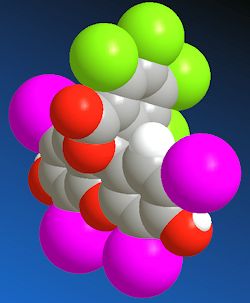
![]()
Rose Bengal
The pink eye stain
that might be a cancer treatment
![]()
Claudia Orellana
Chemistry Teacher, Hereford Sixth Form College.
![]()
Molecule of the Month May 2019
Also available: HTML version.
![]()
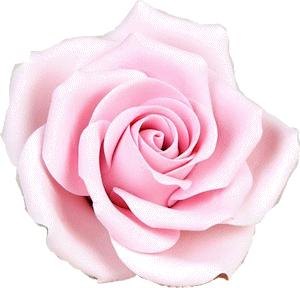
 |
Rose BengalThe pink eye stain
|
 |
It’s a famous woman, right?No, rose, as in the flower, means pink, so it is a pink stain, used in some eye drops. Why would you want pink eyes? Is it a fashion?No, it is a stain for conjunctival and corneal cells used to diagnose damaged tissue in the eye and dry eye conditions. |
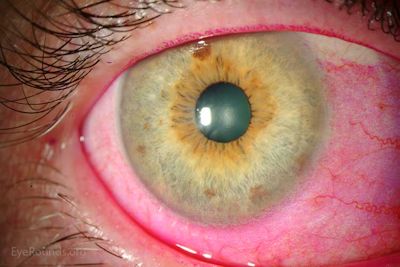 Rose Bengal staining that reveals eye damage. [Photo: Stefani Karakas, CRA. EyeRounds.org, The University of Iowa Creative Commons Attribution-NonCommercial-NoDerivs 3.0 Unported License.] |
 And why is it called rose Bengal?
And why is it called rose Bengal?It is all about the colour, the pink colour of the forehead dot indicating marriage in women of the Bengali region of India (as shown in the photo, left).
Well, you could say that, I suppose.
Apart from the colour, and the pink eyes, well, the fact it was first synthesized in the 19th century as a wool dye. The patent was granted to a Ghnem of Basel, Switzerland, in 1882 for a family of wool dyes. He incorporated chorine and iodine to an existing dye, fluorescein (an orange/red dye commonly used in microscopy), to produce different colour dyes. The dye known currently as rose Bengal was only established a few years later. Rudolf Nietzki at the University of Basel identified the principal constituents of rose Bengal as iodine derivatives of di- and tetra-chlorofluorescein. The original Rose Bengal version incorporated two iodine atoms, and subsequent modifications through the 1920s, adding two more iodine atoms, led to the dye currently called rose Bengal.
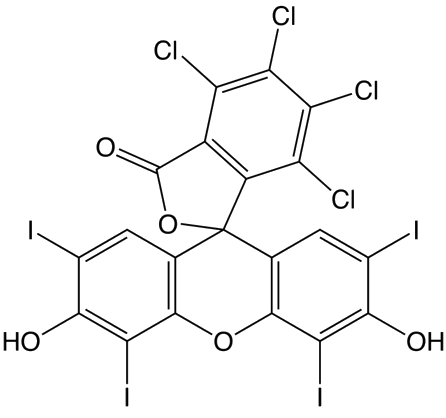 |
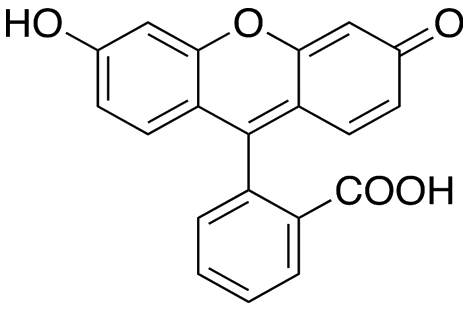 |
| Rose Bengal [Image: Elbreapoly, Public Domain via Wikimedia Commons] |
Fluorescein [Image: Charlesy, Public domain, via Wikimedia Commons] |
Yes, there is that. Stains tend to be purer and be used in medical and microbiological preparations, whereas dyes are more rough and ready and used for textiles. So technically, rose Bengal is stain rather than a dye, but it started off as a dye.
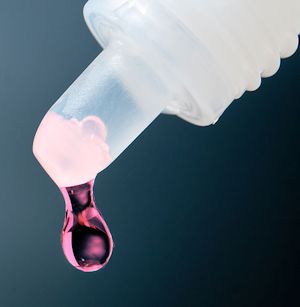 And how did it start to be applied on eyes?
And how did it start to be applied on eyes?It was first used as a treatment for eye infections in 1914, namely ocular pneumococcal infection. But clinical trials in the 1960s and 1970s led to the current use as a stain to visualise eye tissue damage.
The normal tear film around the eyeball stops the absorption of rose Bengal by the eye epithelial cells, but when the tear film is not intact, rose Bengal can be taken up by the cells. This means that dry eye conditions can be revealed and localised. It can also absorbed by damaged epithelial cells, mucus and fibrous tissue. Following instillation with rose Bengal, the eye is observed under white light and the characteristic pink colour is shown if and where there is damage. So, it can help diagnose conditions such as keratoconjunctivitis sicca, tear film deficiencies or early dendritic corneal ulcers, among others. Since the first use in the 1960s, further eye conditions have been added to the list. Ah, and it is used in dogs and horses as well as humans.
Well, it can produce eye-irritation and is slightly toxic to eye cells. Its use is mildly controversial today and studies of its toxicity have led some researchers and clinicians to suggest it might be time for rose Bengal to be replaced. Its toxicity might help to explain why it has antimicrobial activity.
Several. Rose Bengal is photosensitive, as are many coloured compounds. This property is put to use, for instance, in animal models of ischemic stroke. They inject a bolus with rose Bengal into the bloodstream. Then they apply laser light to the region of interest inducing thrombosis for research.
It has also been used in microbiology, for instance, to stain and detect some tricky microorganisms, such as Brucella, which is the pathogen for a common nasty zoonosis (a disease which can be transmitted to humans from animals).
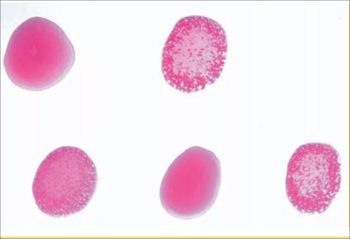
The Rose Bengal test (RBT) is a simple, rapid slide-type agglutination assay
performed with a stained Brucella abortus suspension at pH 3.6–3.7 and plain serum.
[Photo from: microbeonline.com]
Ah, and nano-sutures. A wound can be painted with a rose Bengal preparation and then intense light applied to it. When exposed to light, rose Bengal induces the collagen fibres in the wound to link and seal the wound. This means there is less risk of infection and faster healing.
Recently rose Bengal has being trialled because of its potential anti-cancer activity. The injectable formulation under the name PV-10 is being investigated in clinical trials against melanoma, breast cancer, liver cancer, colon cancer and also skin conditions such as eczema and psoriasis.
It is. It all started in Japan, where rose Bengal had a reincarnation as a food dye. Food colouring stuffs were being tested in the 1980s, because of suspicions that they could cause cancer. Mice in three groups were fed pure water or water with rose Bengal for two years. The expectation was that there would be “severe toxicity to the thyroid” and tumour development. Thyroid goiters caused by excessive intake of iodine through seaweed consumption are common in parts of Japan. After 82 weeks of exposure, dose-dependent survival increases were found in the mice receiving rose Bengal. It was so unexpected that even the authors of the study failed to comment on its significance and the findings were not widely known at the time.
Later, in the 1990s, a group interested in photodynamic agents were looking for anticancer activity among these. They applied data mining to produce a list of a few hundred candidates. Preliminary research with cancer cell lines identified rose Bengal as one of the most promising and then they stumbled across the Japanese paper. Their subsequent animal, and then human studies confirmed that when rose Bengal was injected into tumours, it was a potent and selective anti-cancer agent. Thus, PV-10 was born.
Recent studies are looking into delivery forms. The first trials all tested direct delivery into tumours. But studies from 2017 have found a systemic therapeutic response in mice, which means the immune system responds deals with the tumour with the help of rose Bengal.
Researchers have been focusing more on rose Bengal as an agent in photodynamic therapy. This means that it is not just rose Bengal by itself that stops the cancer cells growing but the fact that it is photosensitive. A light source is used to activate rose Bengal and destroy abnormal cells.
![]()
![]()
![]() Back to Molecule of the Month page. [DOI:10.6084/m9.figshare.7959308]
Back to Molecule of the Month page. [DOI:10.6084/m9.figshare.7959308]